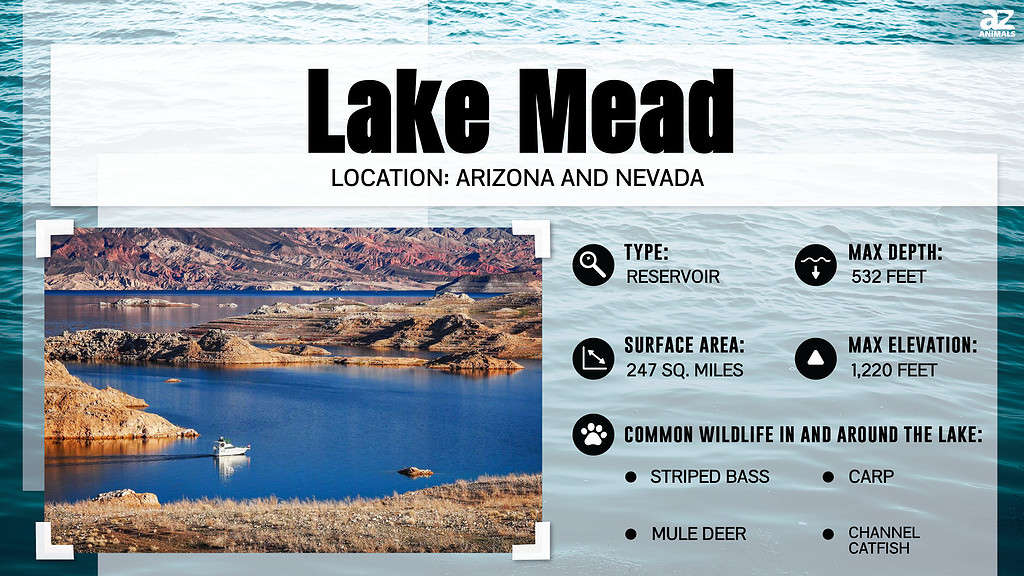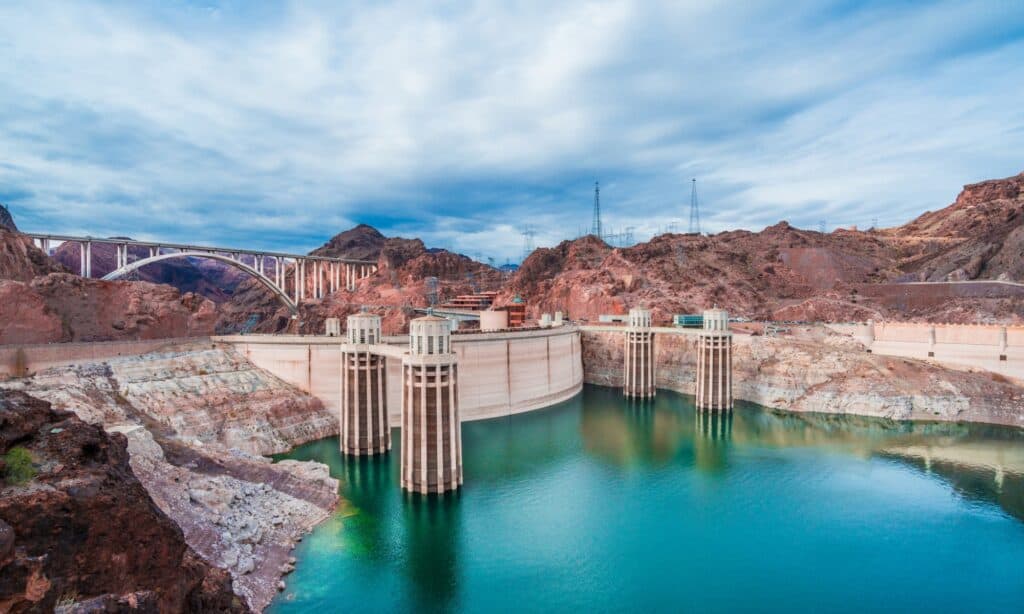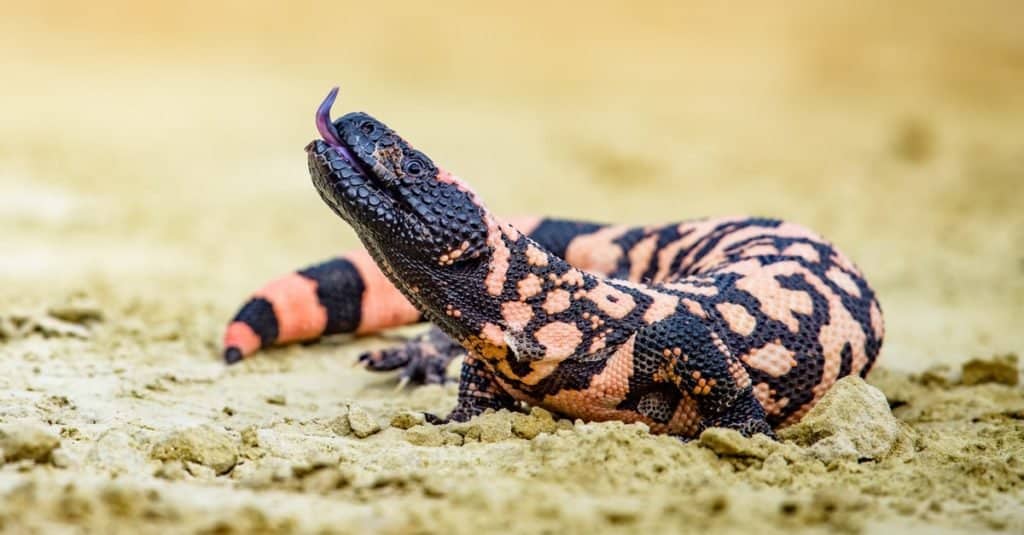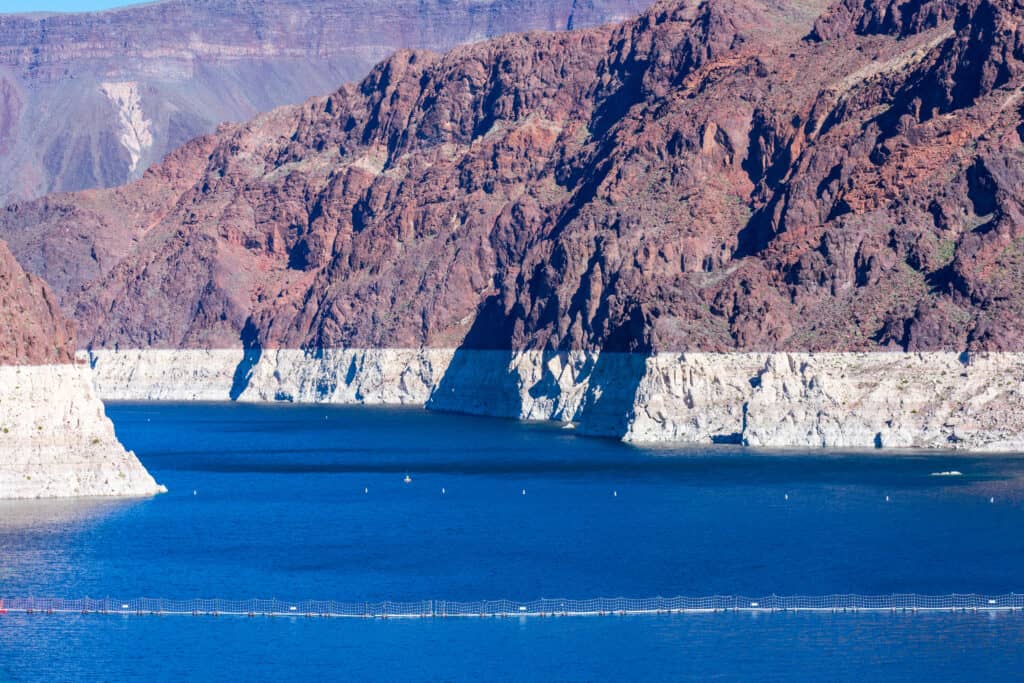
Lake Mead’s dramatically decreased water level has brought concerns about climate change, water consumption, and drought conditions in the Southwest. However, the water shortage has also revealed startling discoveries. Lake Mead’s story is one that exhibits the importance of discovery and conservation. Find out why Lake Mead is drying up and what discoveries have been made within and around the lake’s remaining waters.
Background on Lake Mead

Hoover Dam confines Lake Mead, the United State’s largest reservoir by volume when full.
©iStock.com/superjoseph
Lake Mead is a man-made reservoir of the Hoover Dam. The lake lies just 25 miles from Las Vegas, Nevada, and stretches a maximum of 10 miles wide in some areas. Lake Mead’s surface area measures 229 square miles, making it one of the largest constructed lakes on Earth. Lake Mead is important because it is used as drinking water and as an irrigation source for tens of millions of people in the surrounding regions.
The Lake Mead National Recreation Area has been a place of beauty and activity enjoyed by its visitors for decades. It was founded in 1936, and Lake Mead was recognized as the first national recreation area by Congress in 1964. Specific areas within the Lake Mead National Recreation Area include portions of the Hualapai Indian Reservation and Lake Mohave. Attractions at Lake Mead include fishing, water sports, swimming, and more. On average, Lake Mead receives eight million tourists and other visitors per year.
Animals within and around Lake Mead are diverse and unique to the region. One fish, the razorback sucker, is indigenous to the Colorado River basin. Unfortunately, the razorback sucker is an endangered species whose population continues to decline. Thus, those fishing in Lake Mead and the Colorado River should be careful to release any razorback suckers that they might accidently catch.
Reptiles near Lake Mead include the desert tortoise, desert iguana, and even the Gila monster. The Gila monster is a highly venomous creature, so visitors should be cautious if they stumble across one. Another fascinating animal near the lake is the mountain lion. Mountain lions are beautiful large cats, but they should not be approached if encountered. An American favorite, the bald eagle, can be seen flying in the skies over Lake Mead. Bald eagles often migrate to Lake Mead during winter to escape the harsh northern cold.

Gila monsters are highly venomous, but they release a relatively small amount of venom when they bite.
©Vaclav Sebek/Shutterstock.com
The 3 Reasons Behind Lake Mead’s Decreased Water Levels
Population increases around Lake Mead have caused mass depletion of its waters since 1999. Depletion, alongside other contributing factors, have led to decreased water levels within the lake. In 2020, managers of the reservoir were forced to construct and turn on low-level pumps that extract water during severe drought conditions.
Lake Mead retains just over one-fourth of the water that it was originally filled with, according to reports from July of 2022. The main contributors to Lake Mead’s decreased water levels, besides population growth leading to depletion, include drought and climate change. Lake Mead and surrounding areas have been plagued by drought over the last few years. For instance, 83% of Colorado is experiencing drought at this moment.
Climate change occurs when anthropogenic emissions and pollution result in altered — often negative —effects on climates and ecosystems. While many will blame the drought for decreased water levels in Lake Mead, it’s crucial to understand why these droughts occur. Scientists estimate that 42% of drought conditions near Lake Mead are the result of climate change.
When temperatures rise in dry regions, such as in the Southwest United States, water evaporates rapidly. The lack of moist, warm arm in the Southwest means that rainfall is less likely to occur in this area, leading to drought. Thus, as moisture evaporates more and more rapidly before reaching Lake Mead, the lake is never replenished. On top of that, the water within the lake continues to evaporate, and drought conditions worsen.
Lake Mead’s water levels have dropped so low that a white ring is visible on the surrounding mountains. Many refer to this coloration as the “bathtub ring.” The ring depicts what Lake Mead’s water level had been in the past due to the water’s erosion of the bordering mountains. As a result, scientists can determine how much water Lake Mead has lost and if the decreased water levels signify a water crisis.

The white ring, often referred to as “the bathtub ring,” shows what the water level was in the past due to erosion of the surrounding mountains.
©iStock.com/Michael Vi
Effects of Decreased Water Levels in Lake Mead
Approximately one-tenth of the water within the lake derives from groundwater and precipitation. The remaining 90% comes from melting snowfall, which flows from the Rocky Mountains and into the Colorado River. Due to the decreased snowfall in Colorado and a long-lasting drought, water usage in the Colorado River basin has been reduced to conserve the remaining water in the Colorado River and Lake Mead.
Officials have asked residents of Arizona and Nevada to decrease water usage by 18% and 7% respectively. However, Lake Mead’s water shortage means not only decreased water usage but also a loss of electric power. The Hoover Dam has already decreased the rate at which it produces electricity due to the water shortage. Estimates show that a water level decrease of 100 feet more in Lake Mead may stop the Hoover Dam’s turbines from functioning altogether.
Due to prolonged drought in the Southwest, many estimate that the region is moving toward irreversible aridification. Most scientists believe that drought conditions are unlikely to improve anytime soon. Thus, states have implemented mandates to conserve water. Regulations include decreasing the amount of water used to water lawns and golf courses and a possible decrease in water usage for agricultural purposes.
While Lake Mead is used for drinking water and irrigation, recreational activities have also been halted due to the decreased water levels. Lake Mead had been a popular boating area for several years, but now many boating ramps are closing due to safety concerns and expense. Keeping the boating ramps open is highly expensive as water levels decrease and as topography becomes a greater inhibitor to the ease of boat ramp installation and use.
The water shortage at Lake Mead and the negative effects that have resulted and may result are a clear indication that humans need to both conserve water and limit their use of fossil fuels and other polluting elements in the future. Halting climate change could be key to improving drought conditions and restoring the climate of the Southwest.

These satellite photos from NASA show Lake Mead’s water levels in 2000, 2021, and 2022.
©Public Domain – License
Discoveries at Lake Mead
Decreased water levels and its negative effects were not the only discoveries made at Lake Mead as of late. Bodies and other items have turned up as water levels have gone down. For instance, the body of Thomas Erndt, who disappeared at Lake Mead 20 years ago, was found in May of 2022. In addition, items such as boats and even coffee machines have been found in Lake Mead.
The most startling of discoveries, though, was the number of bodies and other human remains in the lake. The remains of at least five people were found in Lake Mead during the summer of 2022. One barrel discovered in the lake held the remains of someone with a gunshot wound. While the other human remains were determined to be the result of drowning, many believe that the remains exhibiting a gunshot wound could be related to the presence of organized crime in Las Vegas, Nevada.
Although the discovery of human remains in Lake Mead is surely unsettling, it has brought closure to one family. Erndt’s family finally felt peace after finding out that the remains belonged to their family member. They were happy that Erndt had passed away at one of his favorite places, Lake Mead. As Lake Mead’s water levels continue to drop, it’s likely that more discoveries will be made and that more families will gain closure.
The photo featured at the top of this post is © NASA Earth Observatory images by Joshua Stevens, using Landsat data from the U.S. Geological Survey / Public domain, from Wikimedia Commons, the free media repository – License / Original
Sources
- NASA Earth Observatory, Available here: https://earthobservatory.nasa.gov/images/150111/lake-mead-keeps-dropping
- Melissa Denchak, Available here: https://www.nrdc.org/stories/drought-everything-you-need-know?gclid=Cj0KCQiA_P6dBhD1ARIsAAGI7HD8r4i5kVoAeK57zlA0XBRWEBJDWjIhtH-ZcNhqFjciqMCf-ji4kPgaAuv0EALw_wcB#causes
- Mackenzie Brown, Matt Casale, Available here: https://environmentamerica.org/articles/megadrought-intensifies-water-shortage-in-the-lake-mead-reservoir/#:~:text=A%20recent%20study%20in%20the,burning%20fossil%20fuels%20for%20energy
- Britannica, Available here: https://www.britannica.com/place/Lake-Mead
- John Kapetaneas, Stephanie Fasano, Ivan Pereira, Available here: https://abcnews.go.com/US/historic-lake-mead-drought-leads-disturbing-discoveries-dried/story?id=92124028#:~:text=Lake%20Mead's%20water%20levels%20have,drought%20from%20the%20Colorado%20River.&text=Climate%20experts%20and%20local%20officials,as%20the%20drought%20gets%20worse
- National Park Service, Available here: https://www.nps.gov/lake/learn/nature/wildlife.htm
FAQs (Frequently Asked Questions)
Why is Lake Mead drying up?
Lake Mead is drying up due to depletion of its waters, drought, and climate change.
What has been found in Lake Mead?
Boat wreckage, human remains, and other items have been found in Lake Mead.
What will result due to Lake Mead’s decreased water levels?
Water shortage, mandates requiring water conservation, and a decrease in the rate of electric power produced will likely occur due to decreased water levels in Lake Mead.
Thank you for reading! Have some feedback for us? Contact the AZ Animals editorial team.






